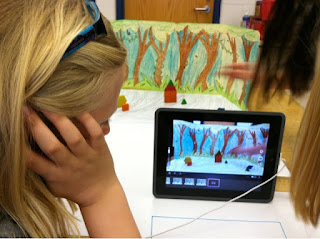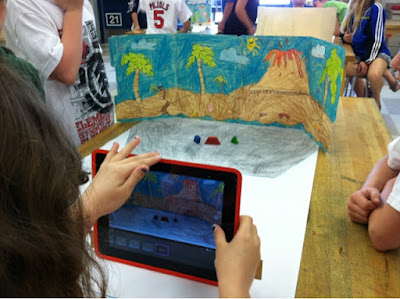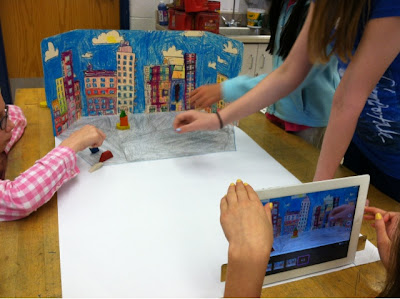ArtShow2013 was a huge success!
I don't even know where to start.
I like to have students pick their best work from the year to display at art show - but I don't have the room to keep portfolios for 500 or so kids and I don't like keep artwork instead of sending it home. So, what I do is this: When we have completed two projects I have the kids pick which one they did better on and send the other home. We do this all year so that we always have something picked out for art show, but artwork also goes home. Often times students pick artwork that I don't feel is their best work - and if I ask them why they pick it, their choice is clear. Students that pick a project that has an end product that is less than their best often pick those because of the process - which is just as important.
 I love doing it this way because it creates a great variety of work for ArtShow - giving both parents and I a year review of what has been happening in the art room.
I love doing it this way because it creates a great variety of work for ArtShow - giving both parents and I a year review of what has been happening in the art room. When we get about a month out from art show we start finalizing projects, signing labels, double and triple checking class lists. It takes about a month to gather all the projects because kids are sick, at Dr. appointments, on vacation, and any other reason for missing art.
Once projects are finalized I added signed labels and QR codes to each and every project.
 Yes QR codes on each project. Why? Other than because I'm crazy - I am always trying to advocate for my program, reaching out to parents in anyway possible. Each QR code leads parents to this blog, and specifically to the blog post about that particular project. I could have made it easier and put the same generic QR code on each project, but that seemed pointless. My goal was, and is, to communicate to parents about the lessons behind the projects - so to make it easy on them each QR code was specialized.
Yes QR codes on each project. Why? Other than because I'm crazy - I am always trying to advocate for my program, reaching out to parents in anyway possible. Each QR code leads parents to this blog, and specifically to the blog post about that particular project. I could have made it easier and put the same generic QR code on each project, but that seemed pointless. My goal was, and is, to communicate to parents about the lessons behind the projects - so to make it easy on them each QR code was specialized. QR codes are EASY to make. Goggle "QR code generator" and you'll get LOTS of hits and websites to make the codes for free. Put in your desired URL (or other info), generate the QR code, download - simple!
QR codes are EASY to make. Goggle "QR code generator" and you'll get LOTS of hits and websites to make the codes for free. Put in your desired URL (or other info), generate the QR code, download - simple!Now, I tried to make this as easy as possible on myself and opened Microsoft Word, downloaded a return address label template, imported the QR code - copy and pasted putting two QR codes on each label. I did this for either a full sheet or half a sheet depending on how many I thought I would need.
 Then I sat on the floor in my house, cut and stuck QR codes to each corresponding project. My cat Phineas was so helpful in this process!
Then I sat on the floor in my house, cut and stuck QR codes to each corresponding project. My cat Phineas was so helpful in this process!The day arrived to set up ArtShow2013. This year I got to be in the Cafetorium, because 2nd grade production was done earlier in the year. I LOVED being in the Cafetorium. I had WAY more room. I spent the day putting up grids, clipping artwork, setting out clay pieces on their own labels.
It looked AWESOME.
 After everything was set out I then needed to set up my light graffiti booth and my stop motion animation area. I asked two teachers with teenage daughters if they would be willing to volunteer sometime to art show. They both agreed and I was thrilled! I had one daughter on the stage, in the dark with an iPad, flashlights, ghost light, and an iPad app called, "Slow Shutter". Here families could make light graffiti together. When I told students there was light graffiti on the stage - their eyes got wide and immediately they were dragging their families to the stage. I used this app instead of a camera because it allowed families to e-mail themselves the photo right after it was made. This way I didn't have to try and figure out which went with what family.
After everything was set out I then needed to set up my light graffiti booth and my stop motion animation area. I asked two teachers with teenage daughters if they would be willing to volunteer sometime to art show. They both agreed and I was thrilled! I had one daughter on the stage, in the dark with an iPad, flashlights, ghost light, and an iPad app called, "Slow Shutter". Here families could make light graffiti together. When I told students there was light graffiti on the stage - their eyes got wide and immediately they were dragging their families to the stage. I used this app instead of a camera because it allowed families to e-mail themselves the photo right after it was made. This way I didn't have to try and figure out which went with what family.I also had a table in the corner set up with Stop Motion animation. Students were introduced to it the week of ArtShow and were eager to share with their parents how it worked. Families worked together through out the night to create the video below.






















